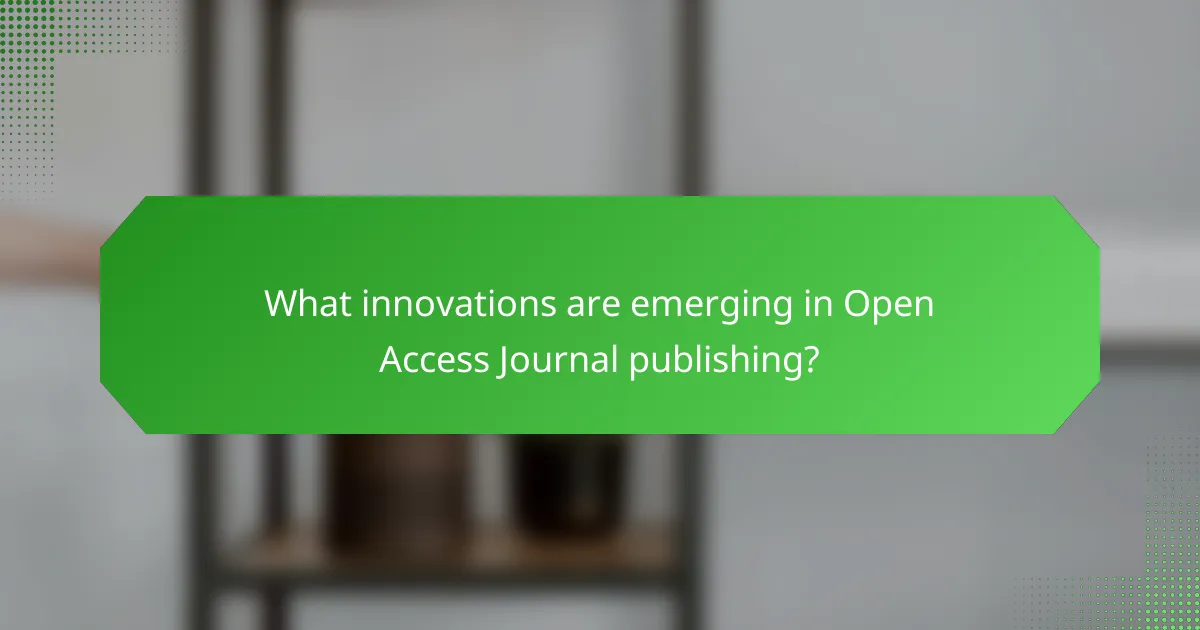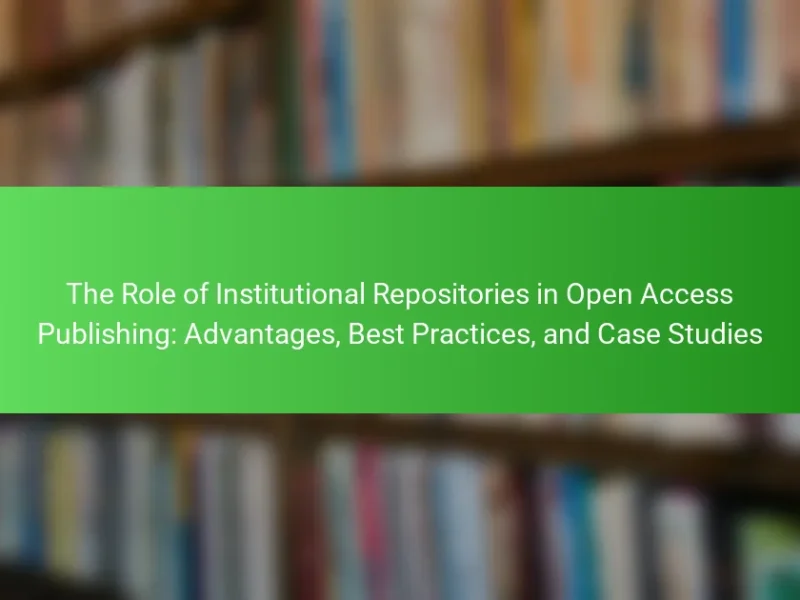Open Access Journals are scholarly publications that provide free and unrestricted access to research articles, promoting wider dissemination of knowledge and enhancing visibility for authors. This article explores the future of Open Access Journals by examining current trends, innovations such as AI-driven content curation and decentralized publishing models, and the perspectives of authors regarding visibility, accessibility, and quality. It highlights the benefits of increased citation rates and collaboration while addressing concerns over publication fees and journal credibility. Overall, the article sheds light on how these developments are shaping a more inclusive academic publishing landscape.

What are Open Access Journals and Their Importance?
Open Access Journals are scholarly publications that provide free, unrestricted access to their content. They allow anyone to read, download, and share research articles without subscription fees. This model promotes wider dissemination of knowledge. It enhances visibility and citation rates for authors. Open Access Journals are crucial for advancing research across disciplines. They support the principle that publicly funded research should be freely accessible to the public. According to a study published in PLOS ONE, Open Access articles are cited 18% more than non-Open Access articles. This increased visibility can lead to more collaboration and innovation in research.
How do Open Access Journals differ from traditional journals?
Open Access Journals provide free access to their content, while traditional journals typically require subscriptions or payment for access. This fundamental difference enhances the visibility and accessibility of research. Open Access Journals often operate under a model funded by article processing charges paid by authors or their institutions. In contrast, traditional journals generally rely on subscription fees from individuals or libraries. According to a 2021 study published in the journal “PLOS ONE,” Open Access articles receive, on average, 18% more citations than those behind paywalls. This indicates that Open Access Journals can increase the impact and dissemination of research findings.
What are the key characteristics of Open Access Journals?
Open Access Journals are scholarly publications that provide free access to their content. They allow anyone to read, download, and share research articles without subscription fees. This model promotes wider dissemination of knowledge. Open Access Journals often employ a peer-review process to maintain quality. They can be funded through author fees, institutional support, or grants. Many are indexed in major databases, enhancing their visibility. The Directory of Open Access Journals (DOAJ) lists thousands of such journals, confirming their prevalence. Overall, Open Access Journals aim to increase accessibility and transparency in research.
Why is accessibility important in academic publishing?
Accessibility in academic publishing is crucial for ensuring that research is available to a wider audience. It allows individuals from diverse backgrounds, including those with disabilities, to access scholarly work. This inclusivity promotes equitable knowledge dissemination. Studies show that accessible content increases readership and engagement. For example, research by the Pew Research Center indicates that broader access leads to higher citation rates. Additionally, open access models enhance transparency in research. This transparency fosters trust in academic findings. Overall, accessibility directly impacts the reach and impact of research in society.
What trends are shaping the future of Open Access Journals?
Open Access Journals are increasingly influenced by several key trends. One major trend is the rise of institutional funding models. Many universities are allocating budgets to support open access publishing. This shift reduces reliance on traditional subscription models. Another trend is the growing demand for transparency in peer review processes. Researchers are advocating for open peer review to enhance accountability. Additionally, there is an increase in the use of preprint servers. These platforms allow researchers to share findings before formal peer review. The adoption of innovative technologies, such as blockchain, is also shaping the landscape. Blockchain can provide secure and transparent record-keeping for publications. Lastly, there is a heightened focus on equitable access to research. Efforts are being made to ensure that open access benefits researchers globally, regardless of funding status.
How is technology influencing the evolution of Open Access Journals?
Technology is significantly influencing the evolution of Open Access Journals by enhancing accessibility and streamlining publication processes. Digital platforms allow for wider dissemination of research findings. This increases visibility and citations for authors. Advanced indexing and search algorithms improve discoverability of articles. Technologies like blockchain ensure transparency and integrity in publishing. Open access models are supported by funding from institutions and governments. The rise of preprint servers accelerates the sharing of research before formal peer review. Data analytics tools help journals assess impact and readership. These technological advancements collectively transform the landscape of scholarly communication.
What role do funding models play in the sustainability of Open Access Journals?
Funding models are crucial for the sustainability of Open Access Journals. They determine how journals cover operational costs and ensure accessibility. Various models exist, including author payment, institutional support, and government funding. Author payment involves charging fees for publishing, which can limit access for some researchers. Institutional support provides financial backing from universities, enhancing journal stability. Government funding can promote equitable access to research. The choice of funding model impacts the journal’s reach and longevity. For instance, a study by the Scholarly Publishing and Academic Resources Coalition found that 60% of Open Access journals rely on author fees. This reliance can affect the diversity of published research. Hence, effective funding models are essential for maintaining the accessibility and quality of Open Access journals.

What innovations are emerging in Open Access Journal publishing?
Innovations in Open Access Journal publishing include enhanced digital platforms, AI-driven content curation, and decentralized publishing models. Enhanced digital platforms improve user experience and accessibility for researchers. AI-driven content curation streamlines article recommendations based on reader preferences and trends. Decentralized publishing models utilize blockchain technology to ensure transparency and author control over their work. These innovations aim to increase visibility, reduce publication costs, and foster collaboration among researchers. The shift towards open peer review processes is also gaining traction, promoting transparency and accountability in the review process. Overall, these advancements are shaping a more inclusive and efficient academic publishing landscape.
How are new publishing platforms changing the landscape?
New publishing platforms are transforming the landscape by enhancing accessibility and democratizing content creation. These platforms allow authors to share their work without traditional barriers, such as high publication fees. Open access models enable wider distribution, increasing readership and citation rates. For instance, studies show that articles published in open access journals receive 30% more citations than those in subscription-based journals. Furthermore, new platforms often incorporate innovative technologies like blockchain for secure and transparent publishing. They also facilitate collaboration among researchers globally, fostering diverse perspectives. This shift supports a more inclusive academic environment, benefiting both authors and readers.
What are the benefits of decentralized publishing systems?
Decentralized publishing systems provide increased control for authors over their work. This model allows for direct engagement with readers without intermediaries. It enhances transparency in the publishing process. Authors can retain more rights to their intellectual property. Decentralization can reduce costs associated with traditional publishing. It fosters collaboration among researchers across various disciplines. According to a study by the MIT Media Lab, decentralized systems can improve accessibility to academic content. These systems also promote innovation by enabling diverse content formats and distribution methods.
How do innovations in peer review processes enhance quality?
Innovations in peer review processes enhance quality by increasing transparency and accountability. New methods, such as open peer review, allow for public scrutiny of reviewer comments and author responses. This openness encourages constructive feedback and reduces bias. Automated tools for plagiarism detection and statistical analysis improve the rigor of evaluations. Additionally, the use of preprint servers allows for early feedback before formal publication. These innovations lead to higher quality research outputs by fostering collaboration and improving the overall review experience. Studies show that transparent peer review can increase the trustworthiness of published research.
What impact do these innovations have on authors and researchers?
Innovations in open access journals significantly enhance authors’ visibility and accessibility. These advancements facilitate quicker dissemination of research findings. Authors can share their work without paywalls, reaching broader audiences. Increased visibility can lead to higher citation rates and greater impact. Researchers benefit from real-time feedback and collaboration opportunities. Innovations also streamline the submission and peer-review processes, saving time. According to a study by Piwowar et al. (2018), open access articles are cited 18% more than subscription-based articles. This trend underscores the positive effects of innovations on authors and researchers.
How do authors perceive the changes in Open Access publishing?
Authors generally perceive changes in Open Access publishing positively. They appreciate increased visibility and accessibility of their work. Open Access allows broader dissemination of research findings. Authors recognize that this model can enhance citation rates and impact. However, some express concerns about publication fees. High article processing charges can pose financial barriers. Additionally, authors worry about the quality of some Open Access journals. They seek assurance that their work is published in reputable venues. Overall, the shift towards Open Access is seen as a promising development in scholarly communication.
What challenges do authors face in the Open Access model?
Authors face several challenges in the Open Access model. One major challenge is the publication fees, known as Article Processing Charges (APCs). These fees can be prohibitively high for some authors, limiting their ability to publish. Additionally, the quality of Open Access journals varies widely. Some journals may lack rigorous peer review processes. This inconsistency can affect an author’s reputation and the impact of their work.
Another challenge is the visibility of published work. While Open Access aims to increase accessibility, not all Open Access journals are well-indexed in databases. This can hinder discoverability and citation rates. Authors also face pressure to publish quickly, which can compromise the quality of their research.
Furthermore, the Open Access model can lead to misunderstandings about copyright. Authors may inadvertently lose rights to their work when publishing. Finally, there is a stigma attached to some Open Access journals, leading to concerns about academic legitimacy. These challenges collectively impact authors’ experiences in the Open Access landscape.

What perspectives do authors have on Open Access Journals?
Authors generally view Open Access Journals positively. They appreciate the increased visibility and accessibility of their work. Open Access allows research to reach a broader audience, enhancing citation rates. Many authors believe it democratizes knowledge by removing paywalls. However, some express concerns about publication fees and the quality of certain journals. Authors often emphasize the importance of reputable Open Access platforms. They argue that rigorous peer review should be maintained. Overall, perspectives vary but lean towards favoring Open Access for its benefits.
How do authors view the benefits of publishing in Open Access Journals?
Authors view the benefits of publishing in Open Access Journals as significant for increasing visibility and accessibility. They believe Open Access allows broader dissemination of their research to a global audience. This increased reach can enhance citation rates and impact within the academic community. Many authors appreciate the transparency and availability of research findings without paywalls. According to a study published in 2021 by PLOS ONE, 68% of authors reported higher readership for their Open Access articles compared to traditional journals. Authors also value the potential for collaboration and engagement with diverse audiences. Overall, the consensus is that Open Access publishing fosters a more inclusive and impactful research environment.
What are the perceived advantages for authors in terms of visibility?
Authors perceive increased visibility through open access journals. Open access allows their work to reach a broader audience without paywalls. This accessibility can enhance citation rates. Studies show open access articles are cited more frequently than those behind paywalls. Authors can build their reputation more effectively in their field. Increased visibility can lead to more collaboration opportunities. Open access also allows for greater engagement with the public. Overall, these factors contribute to a more significant impact in their respective disciplines.
How does Open Access affect citation and impact factors?
Open Access significantly increases citation rates and impact factors of scholarly articles. Research indicates that Open Access articles receive up to 50% more citations than traditional subscription-based articles. This increase is attributed to greater visibility and accessibility of research findings. Open Access allows wider dissemination of knowledge, enabling more researchers and practitioners to access and cite the work. Studies, such as those published in PLOS ONE, demonstrate a clear correlation between Open Access publishing and higher citation counts. Additionally, journals that adopt Open Access models often experience improved impact factors due to the higher volume of citations. Thus, Open Access positively influences both citation rates and impact factors in academic publishing.
What concerns do authors express about Open Access publishing?
Authors express concerns about Open Access publishing primarily regarding funding and quality. Many authors worry about the sustainability of funding models for Open Access journals. They fear that high article processing charges may limit accessibility for researchers without institutional support. Additionally, there is concern about the peer review process’s rigor in some Open Access journals. Authors often question whether these journals maintain the same quality standards as traditional publishing. Furthermore, there are apprehensions about the potential for predatory journals that exploit the Open Access model. This can lead to the publication of low-quality research. Overall, these concerns highlight the need for transparency and quality assurance in Open Access publishing.
How do authors feel about publication fees and costs?
Authors generally express mixed feelings about publication fees and costs. Many authors appreciate the open access model for increasing visibility and accessibility of their work. However, they often feel burdened by the financial implications of publication fees. A survey by the Scholarly Publishing and Academic Resources Coalition found that over 60% of authors are concerned about the rising costs of publication. Additionally, some authors believe that high fees may limit participation from researchers in low-income countries. This concern highlights the potential inequity in access to publishing opportunities. Overall, while authors value open access, they seek more affordable options for publication.
What are the common misconceptions about Open Access Journals?
Common misconceptions about Open Access Journals include the belief that they are of lower quality than traditional journals. In reality, many Open Access Journals employ rigorous peer-review processes. Another misconception is that Open Access means free to publish without costs. Most journals charge article processing fees that authors or their institutions must pay. Some people think all Open Access Journals are predatory. However, reputable Open Access Journals follow established standards and are indexed in recognized databases. There is also a belief that Open Access Journals do not have impact factors. Many reputable Open Access Journals have significant impact factors, reflecting their influence in the academic community. Lastly, some assume that Open Access content is not discoverable. In fact, Open Access articles are often more accessible and indexed by search engines and databases, increasing visibility.
What best practices should authors follow when choosing Open Access Journals?
Authors should prioritize reputable Open Access Journals with transparent peer review processes. They should verify the journal’s indexing in recognized databases like Scopus and Web of Science. Authors must assess the journal’s impact factor or other metrics reflecting its influence. Reviewing the editorial board’s qualifications can indicate the journal’s credibility. Authors should also check for publication fees and funding sources for transparency. It’s essential to read previous articles to gauge the journal’s scope and quality. Lastly, authors should ensure compliance with their institution’s Open Access policies.
Open Access Journals are scholarly publications that provide free access to research content, promoting wider dissemination of knowledge and enhancing visibility for authors. This article examines the importance of Open Access Journals, contrasting them with traditional journals, and highlights their key characteristics and trends shaping their future. It also discusses the impact of technology and funding models on their sustainability, explores innovations in publishing and peer review processes, and presents authors’ perspectives on the benefits and challenges of Open Access publishing. The article aims to provide a comprehensive overview of the evolving landscape of Open Access Journals and their significance in academic communication.


